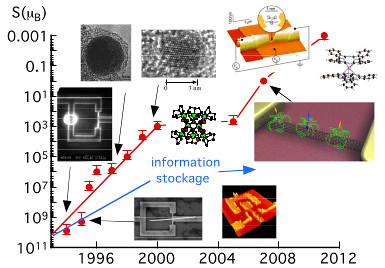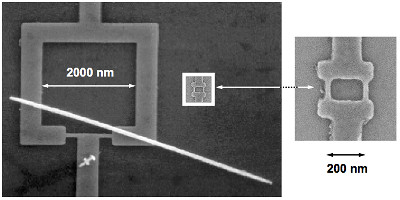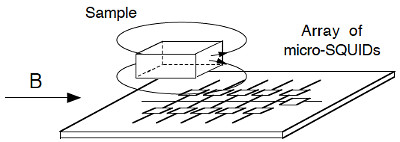Micro-SQUID technique to study magnetic nanostructures
In Grenoble, Institut Néel, NanoSpin, we developed a worldwide unique equipment: a microSQUID magnetometer which is 109 times more sensitive than conventional SQUID magnetometers. This magnetometer allows the measurement of very small magnetic crystals, single nanoparticles and magnetic molecules. These Nb micro-SQUIDs operate below 8 K and in fields up to 10 T. The field can be applied in any direction by separately driving three orthogonal coils. Routine studies comprise hysteresis loops, quantum tunneling of magnetization, and relaxation profiles. The setup is also equipped with microwave generators for photon activation of fast dynamics. Methods have been developed to probe environmental decoherence effects, such as quantum hole digging to measure hyperfine, dipolar or exchange coupling effects. New measurement schemes are being developed for applications in information storage and quantum computing.The interface between classical and quantum physics has always been an interesting area, but its importance has nevertheless grown with the current explosive thrusts in nanoscience. Taking devices to the limit of miniaturization (the mesoscale and beyond) where quantum effects become important makes it essential to understand the interplay between the classical properties of the macroscale and the quantum properties of the microscale.
 |
|
Fig. 1: Roadmap of the micro-SQUID technique in Grenoble (Institut Néel, NanoSpin). The first studied systems were micrometer-sized particles containing about 1010 magnetic moment. During the following years, the micro-SQUID technique has been improved to study smaller and smaller systems. In 2000, clusters containing about 103 magnetic moments could be studied. In 2006, we developed nano-SQUIDs with carbon nanotube Josephson junctions, being able to study single molecular nanomagnets. In 2012, a molecular spin-transistor allowed us to measure the dynamics of a single nuclear spin. |
Project
Characterizing new molecules is vital for our projects, as is our interaction with the chemists in order to optimize the physical and, in particular, the magnetic properties of the molecules. Our studies will be divided into several parts:
- Carrying out extensive characterization of the hysteresis properties, quantum tunnelling of magnetization, and relaxation profiles of the compounds. This allows us to quickly select the best compounds for a more detailed study.
- Using more specific methods in order to learn more about environmental decoherence effects. For example, the quantum hole digging method that we developed can measure the effect of hyperfine, dipolar or exchange coupling. The Landau-Zener method will be used to determine tunnel splittings, needed to understand the quantum dynamics.
- Developing new measurement schemes, using special DC and AC field sequences, for possible applications for information storage and quantum computing.
- Due to the technical difficulties in spatially localizing a magnetic field, the use of an electric field is more appropriate, if one wants to manipulate single nanoobjects. We therefore intend to examine experimentally the effect of an electric field on the properties of electron and nuclear spins.
 |
|
Fig. 2: Scanning electron micrographs of Nb nano-bridge-DC-SQUIDs fabricated by electron beam lithography. (left) An Ni wire of diameter of about 90 nm was deposited on the micro-SQUID of 2000 x 2000 nm2. (right) The nano-SQUID has a loop size of 100 x 200 nm2 and is plotted at the same scale on the left.
|
 |
| Fig. 3: Schematic representation of our magnetometer which is an array of micro-SQUIDs. Its high sensitivity allows us to study single crystals of the order of 10 to 500 micrometers, which are placed directly on the array. |
References:
Wernsdorfer, W.
Classical and quantum magnetization reversal studied in nanometer-sized particles and clusters.
Advances In Chemical Physics, 118, 99-190 (2001)
Cleuziou, J. .. P.; Wernsdorfer, W.; Bouchiat, V.; Ondarcuhu, T. & Monthioux, M.
Carbon nanotube superconducting quantum interference device.
Nature Nanotechnology, 1, 53-59 (2006)
Wernsdorfer, W.
From micro- to nano-SQUIDs: applications to nanomagnetism.
Superconductor Science & Technology, 22, 064013 (2009)

